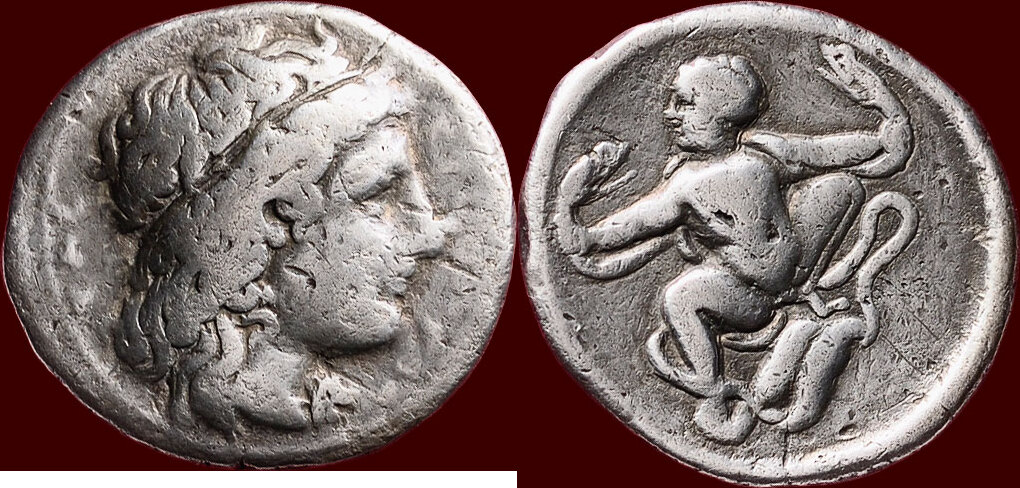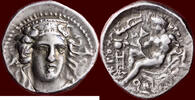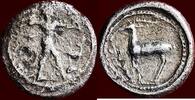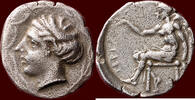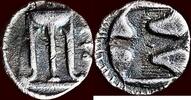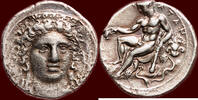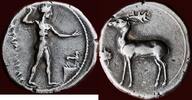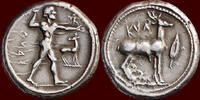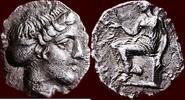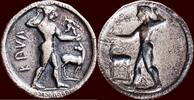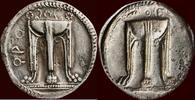MA-ID: 7999602010
Bewertungen Henzen
Schnelle Lieferung. Super Ware. Vielen Dank!
O.K.
perfekt !!!
Great coin, quick delivery, thanks!
400-325 BC v. Chr. BRUTTIUM, KROTON (CROTON) - AR Nomos or tridrachm, circa 400-325 BC cf. The new York Sale XVII, lot 117 (in ss : USD 8.500+ 15%)
Munthandel G.Henzen 

10
Seit 10 Jahren bei MA-Shops
7244 Bewertungen,
100 % Positiv (seit 24 Monaten)
Weltweiter Versand
3750,00 EUR
Differenzbesteuert nach §25a UStG
zzgl. 18,00 EUR Versand ( nach Deutschland )
Lieferzeit: 5 - 8 Tage*
zzgl. 18,00 EUR Versand ( nach Deutschland )
| Bestellhotline +49 (0)2871 2180 383 |
| Zahlungsarten |
| Überweisung |
cf. The new York Sale XVII, lot 117 (in ss : USD 8.500+ 15%) | Abkürzungen
Jameson 434 | SNG.ANS.387 | SNG.München 1460 | SNG.Lloyd 617 Boston 191 | Historia Numorum, Italy 2157
21,50 mm
weight 7,09gr. | silver Ø 21,5mm.
obv. Head of Apollo facing to right, his hair long and flowing,
wearing a laurel-wreath and a necklace with a lion′s head ornament.
rev. The naked infant Herakles seated facing on sushions,
strangling two serpents which he holds in each hand
On the night that Herakles was to be born, Hera, knowing of her husband Zeus his adultery with the mortal Alkmene, persuaded Zeus to swear an oath that the child born that night to a member of the House of Perseus would be High King. Hera did this knowing that while Herakles was to be born a descendant of Perseus, so too was Eurystheos, son of Sthenelos. Once the oath was sworn, Hera hurried to Alkmene her dwelling and slowed the birth of Herakles by forcing Ilithyia, goddess of childbirth, to sit crosslegged with her clothing tied in knots, thereby causing Herakles to be trapped in the womb. Meanwhile, Hera caused Eurystheos to be born prematurely, making him High King in place of Herakles. She would have permanently delayed the birth of Herakles had she not been foiled by Galanthis, servant of Alkmene, who lied to Ilithyia, saying that Alkmene had already delivered the baby. Upon hearing this, she jumped in surprise, untying the knots and thus allowing Alkmene to give birth to Herakles. Having failed to prevent his birth, Hera sent two serpents to kill the baby Herakles as he lay in his cot. While his twin brother Iphikles screamed in terror, Herakles throttled the snakes, one in each hand, and was found by his nurse playing with their limp bodies as if they were toys.
The reverse motif is iconographically based on the symbolism of the Asia Minor cities of Ephesus, Byzantium, Cyzicus, Samos, Knidos and Iasos from the late 5th and early 4th centuries BC. However, a closer look reveals clear stylistic and compositional differences. While the Asia Minor coin depicts the boy Heracles flatly unfolded, comparatively passive, with arms surrounded by snakes, the Crotonian work gains significant depth due to the right leg bent forward. The dynamics of the event and the strength of the child hero are emphasized by the fact that the hero bravely looks one of the attacking snakes in the eye and grabs both of them by the collar at the same time, while pushing their bodies apart with strong arms. These compositional advances not only reflect a different artist′s hand, but also a difference in time, which is also confirmed by the obverse, which is obviously stylistically later. There is therefore probably no direct temporal connection with the influences of Asia Minor.
The reverse type of this coin is symbolic of the struggle of several South Italian cities against the tyrant Dionysios I. Highly interesting and very rare cointype.
cf. The new York Sale XVII, lot 117 (in vf : USD 8.500 + 15%)
cf. Künker Auktion 367, lot 7039 (in vf: € 10.000 + 25%)
cf. Gorny & Mosch, Auktion 297, Lot 1033 (in vf with light scratches: 13.000 + 23%)
Jameson 434 | SNG.ANS.387 | SNG.München 1460 |
SNG.Lloyd 617 Boston 191 | Historia Numorum, Italy 2157 RR
f/vf
obv. Head of Apollo facing to right, his hair long and flowing,
wearing a laurel-wreath and a necklace with a lion′s head ornament.
rev. The naked infant Herakles seated facing on sushions,
strangling two serpents which he holds in each hand
On the night that Herakles was to be born, Hera, knowing of her husband Zeus his adultery with the mortal Alkmene, persuaded Zeus to swear an oath that the child born that night to a member of the House of Perseus would be High King. Hera did this knowing that while Herakles was to be born a descendant of Perseus, so too was Eurystheos, son of Sthenelos. Once the oath was sworn, Hera hurried to Alkmene her dwelling and slowed the birth of Herakles by forcing Ilithyia, goddess of childbirth, to sit crosslegged with her clothing tied in knots, thereby causing Herakles to be trapped in the womb. Meanwhile, Hera caused Eurystheos to be born prematurely, making him High King in place of Herakles. She would have permanently delayed the birth of Herakles had she not been foiled by Galanthis, servant of Alkmene, who lied to Ilithyia, saying that Alkmene had already delivered the baby. Upon hearing this, she jumped in surprise, untying the knots and thus allowing Alkmene to give birth to Herakles. Having failed to prevent his birth, Hera sent two serpents to kill the baby Herakles as he lay in his cot. While his twin brother Iphikles screamed in terror, Herakles throttled the snakes, one in each hand, and was found by his nurse playing with their limp bodies as if they were toys.
The reverse motif is iconographically based on the symbolism of the Asia Minor cities of Ephesus, Byzantium, Cyzicus, Samos, Knidos and Iasos from the late 5th and early 4th centuries BC. However, a closer look reveals clear stylistic and compositional differences. While the Asia Minor coin depicts the boy Heracles flatly unfolded, comparatively passive, with arms surrounded by snakes, the Crotonian work gains significant depth due to the right leg bent forward. The dynamics of the event and the strength of the child hero are emphasized by the fact that the hero bravely looks one of the attacking snakes in the eye and grabs both of them by the collar at the same time, while pushing their bodies apart with strong arms. These compositional advances not only reflect a different artist′s hand, but also a difference in time, which is also confirmed by the obverse, which is obviously stylistically later. There is therefore probably no direct temporal connection with the influences of Asia Minor.
The reverse type of this coin is symbolic of the struggle of several South Italian cities against the tyrant Dionysios I. Highly interesting and very rare cointype.
cf. The new York Sale XVII, lot 117 (in vf : USD 8.500 + 15%)
cf. Künker Auktion 367, lot 7039 (in vf: € 10.000 + 25%)
cf. Gorny & Mosch, Auktion 297, Lot 1033 (in vf with light scratches: 13.000 + 23%)
Jameson 434 | SNG.ANS.387 | SNG.München 1460 |
SNG.Lloyd 617 Boston 191 | Historia Numorum, Italy 2157 RR
f/vf
Bitte beachten Sie unsere Mindestabnahme von 20 Euro. Sendungen nach China sind auf Gefahr des Käufers und nur Zahlung per banküberweisung. An PayPal und Kreditkarte Zahlungen sind immer Verwaltungs- und Risikokosten verbunden. Sendungen nach Russland, Ukraine und israel sind nicht möglich. Der Versand erfolgt innerhalb von 5 Tagen nach Zahlungseingang. BITTE KEIN PAYPAL ODER KREDITKARTE ZAHLUNGEN FÜR EU. Zahlen Sie bitte immer nur mit IBAN; schnell, billig und zuverlässich.
| Versandkosten | ||||
|---|---|---|---|---|
| bis 100,00 EUR | 100,00 EUR bis 500,00 EUR | 500,00 EUR bis 1000,00 EUR | über 1000,00 EUR | |
| Argentinien | 32,00 EUR | 32,00 EUR | 40,00 EUR | 40,00 EUR |
| Australien | 35,00 EUR | 35,00 EUR | 40,00 EUR | 40,00 EUR |
| Belgien | 9,50 EUR | 11,00 EUR | 13,00 EUR | 18,00 EUR |
| Brasilien | 55,00 EUR | 55,00 EUR | 55,00 EUR | 55,00 EUR |
| Bulgarien | 14,00 EUR | 16,00 EUR | 35,00 EUR | 45,00 EUR |
| Chile | 50,00 EUR | 50,00 EUR | 50,00 EUR | 50,00 EUR |
| China | 40,00 EUR | 40,00 EUR | 50,00 EUR | 50,00 EUR |
| Dänemark | 11,50 EUR | 13,00 EUR | 16,00 EUR | 20,00 EUR |
| Deutschland | 9,50 EUR | 11,00 EUR | 13,00 EUR | 18,00 EUR |
| Estland | 13,00 EUR | 14,00 EUR | 15,00 EUR | 25,00 EUR |
| Frankreich | 9,50 EUR | 11,00 EUR | 16,00 EUR | 25,00 EUR |
| Griechenland | 15,00 EUR | 25,00 EUR | 30,00 EUR | 35,00 EUR |
| Großbritannien | 25,00 EUR | 25,00 EUR | 26,00 EUR | 28,00 EUR |
| Hong Kong | 40,00 EUR | 40,00 EUR | 50,00 EUR | 50,00 EUR |
| Indien | 35,00 EUR | 35,00 EUR | 40,00 EUR | 50,00 EUR |
| Indonesien | 35,00 EUR | 35,00 EUR | 40,00 EUR | 40,00 EUR |
| Israel | 200,00 EUR | 200,00 EUR | 200,00 EUR | 200,00 EUR |
| Japan | 40,00 EUR | 40,00 EUR | 40,00 EUR | 40,00 EUR |
| Kambodscha | 65,00 EUR | 65,00 EUR | 65,00 EUR | 65,00 EUR |
| Kanada | 30,00 EUR | 30,00 EUR | 35,00 EUR | 35,00 EUR |
| Liechtenstein | 20,00 EUR | 20,00 EUR | 25,00 EUR | 25,00 EUR |
| Luxemburg | 11,00 EUR | 13,00 EUR | 16,00 EUR | 25,00 EUR |
| Malaysia | 35,00 EUR | 35,00 EUR | 40,00 EUR | 45,00 EUR |
| Niederlande | 8,50 EUR | 8,50 EUR | 11,00 EUR | 14,00 EUR |
| Norwegen | 25,00 EUR | 25,00 EUR | 30,00 EUR | 35,00 EUR |
| Österreich | 11,50 EUR | 12,50 EUR | 15,00 EUR | 25,00 EUR |
| Polen | 13,00 EUR | 14,00 EUR | 16,50 EUR | 25,00 EUR |
| Portugal | 13,00 EUR | 14,00 EUR | 18,00 EUR | 25,00 EUR |
| Rumänien | 16,00 EUR | 18,00 EUR | 25,00 EUR | 35,00 EUR |
| Russische Föderation | 200,00 EUR | 200,00 EUR | 200,00 EUR | 200,00 EUR |
| Schweiz | 30,00 EUR | 30,00 EUR | 40,00 EUR | 40,00 EUR |
| Serbien | 25,00 EUR | 25,00 EUR | 30,00 EUR | 35,00 EUR |
| Singapur | 35,00 EUR | 35,00 EUR | 35,00 EUR | 40,00 EUR |
| Slowakei | 13,00 EUR | 15,00 EUR | 20,00 EUR | 25,00 EUR |
| Spanien | 11,50 EUR | 13,50 EUR | 16,50 EUR | 25,00 EUR |
| Sri Lanka | 35,00 EUR | 35,00 EUR | 40,00 EUR | 45,00 EUR |
| Tschechische Republik | 12,00 EUR | 14,00 EUR | 18,00 EUR | 25,00 EUR |
| Ukraine | 200,00 EUR | 200,00 EUR | 200,00 EUR | 200,00 EUR |
| Ungarn | 14,00 EUR | 16,00 EUR | 25,00 EUR | 30,00 EUR |
| Vereinigte Staaten von Amerika | 32,00 EUR | 32,00 EUR | 35,00 EUR | 40,00 EUR |
| Europäische Union | 15,00 EUR | 17,00 EUR | 25,00 EUR | 30,00 EUR |
| Welt | 40,00 EUR | 40,00 EUR | 50,00 EUR | 50,00 EUR |
Informationen zum Kauf bei MA-Shops
Bestellungen bei MA-Shops sind jederzeit möglich und werden innerhalb von 2-4 Arbeitstagen verschickt.
Ein über die MA-Shops abgesicherter Kauf findet niemals außerhalb von MA-Shops statt.
Bestellen Sie sicher online mit dem MA-Shops Warenkorb.
Vielen Dank.
Ein über die MA-Shops abgesicherter Kauf findet niemals außerhalb von MA-Shops statt.
Bestellen Sie sicher online mit dem MA-Shops Warenkorb.
Vielen Dank.
|
Verkäufer-Startseite | 0Warenkorb | AGB | Impressum | MA AGB | Datenschutzerklärung | Garantie | MA-Shops Neuzugänge Copyright ® 2001-2025, MA-SHOPS Muenzen All Rights Reserved. Designated trademarks and brands are the property of their respective owners. |
 Münzen beim Fachhändler kaufen
Münzen beim Fachhändler kaufen


